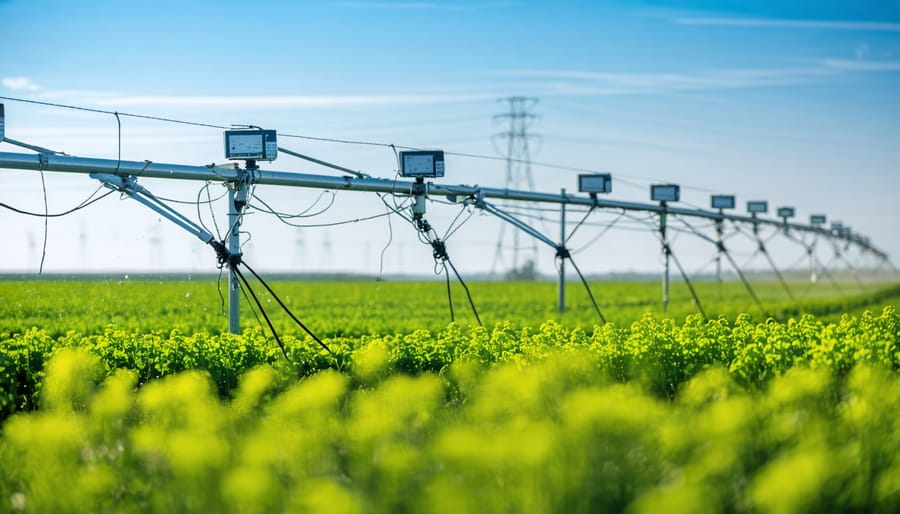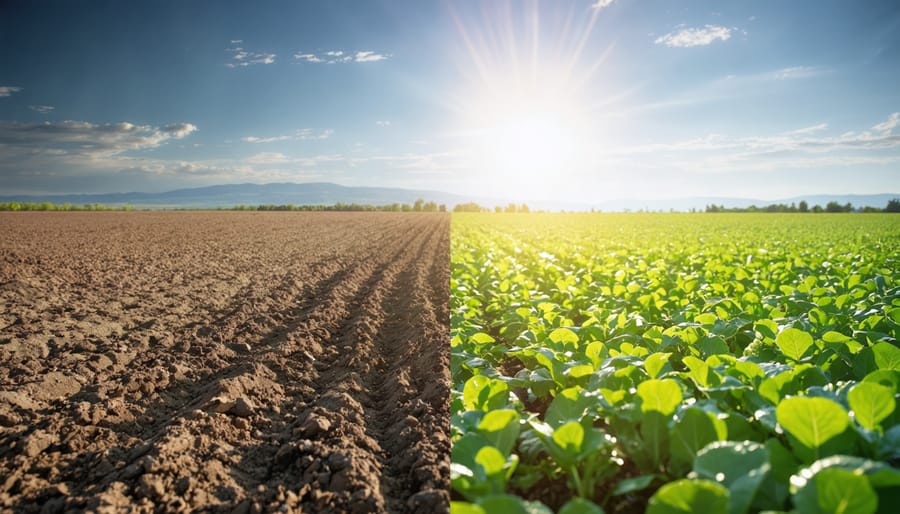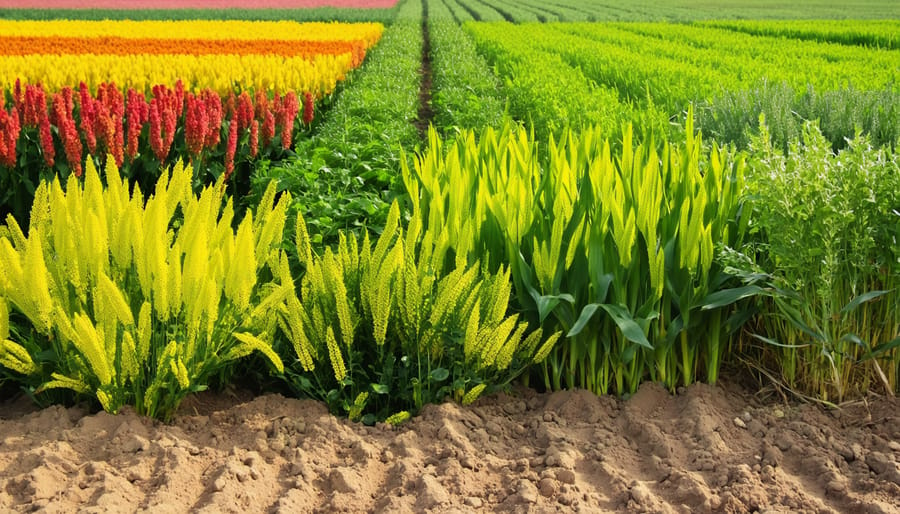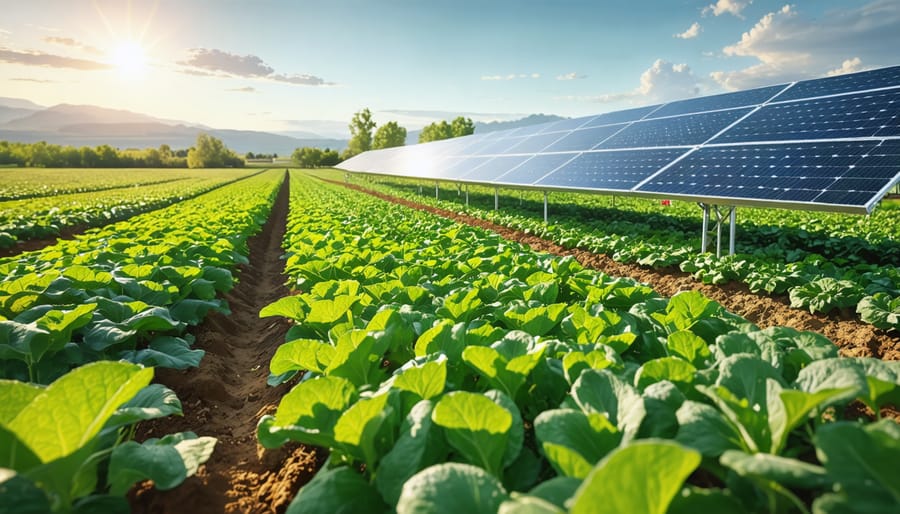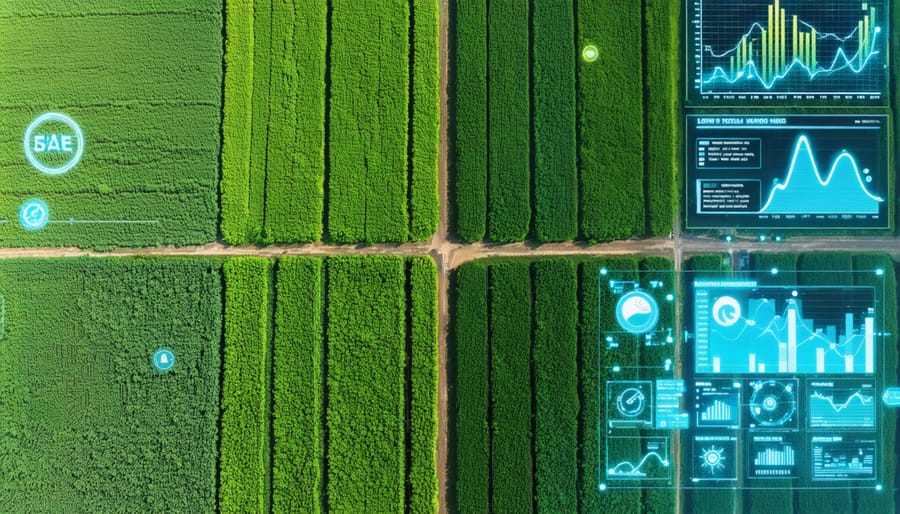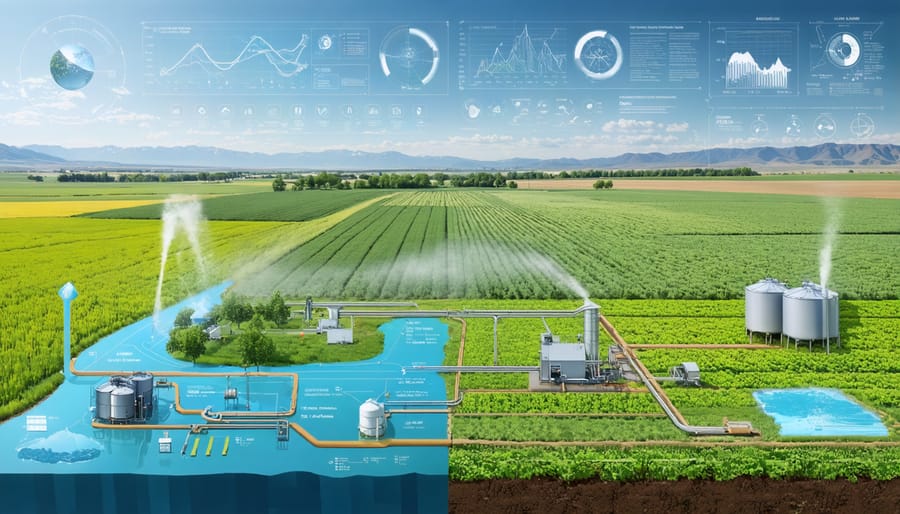Maximize soil water retention by layering organic mulch 4-6 inches deep across cultivated areas, reducing evaporation by up to 70% during Alberta’s climate challenges. Incorporate well-rotted compost at 25-30 tonnes per hectare to create a soil structure that holds 30% more moisture than untreated ground. Install subsurface drip irrigation 15-20 cm below grade, cutting water usage by 40% while maintaining optimal soil moisture levels. Test soil organic matter content quarterly – each 1% increase in organic matter helps soil retain an additional 25,000 litres of water per hectare.
These proven water-retention strategies have helped Prairie farmers reduce irrigation needs by up to 50% during drought conditions. With 90% of Alberta’s agricultural land facing increasing moisture stress, implementing these moisture-conservation techniques isn’t just about survival – it’s about building resilient, productive farmland that thrives despite challenging growing conditions.
The Science Behind Soil Water Retention
Understanding Your Soil’s Natural Water-Holding Capacity
Alberta’s diverse landscape features several predominant soil types, each with unique soil moisture retention techniques and characteristics. The Black Chernozemic soils, common in central Alberta, naturally hold more water due to their high organic matter content and clay particles. These soils typically retain 200-250 mm of water per metre of depth, making them ideal for crop production.
In contrast, the Brown Chernozemic soils found in southeastern Alberta have lower organic matter content and retain approximately 150-175 mm of water per metre. Sandy soils, scattered throughout the province, present the greatest challenge, holding only 100-125 mm of water per metre.
Understanding your soil’s natural capacity is the first step toward effective water management. Simple tests like the ribbon test can help determine your soil type: moist clay soil forms a long ribbon when squeezed, while sandy soil barely holds together. Loam soils, considered ideal for farming, form a medium ribbon and typically retain 175-200 mm of water per metre, providing a good balance for most crops.
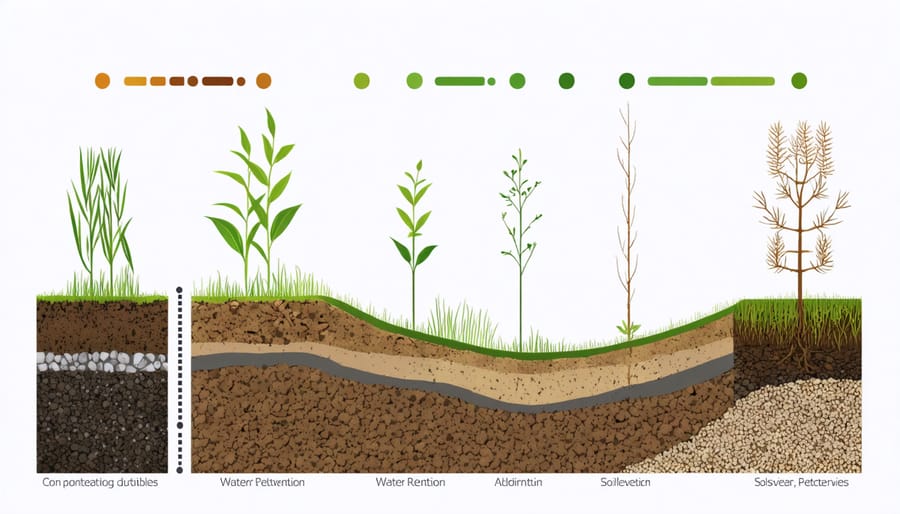
Key Factors Affecting Moisture Retention
Several key factors work together to influence how well your soil retains moisture, and understanding these can help you make better land management decisions. Organic matter content plays a crucial role – for every 1% increase in organic matter, soil can hold an additional 25,000 litres of water per hectare. This is particularly relevant for our Alberta farmers, who often face challenging weather patterns.
Soil structure, especially the arrangement and stability of soil aggregates, significantly impacts water retention. Well-structured soil creates ideal pore spaces that hold water while allowing proper drainage and root growth. Clay content, while sometimes challenging to work with, can be beneficial for water retention when properly managed.
Environmental factors like temperature, wind exposure, and surface cover also affect moisture retention. Many local farmers have found success using crop residue management and cover crops to protect soil from excessive evaporation. These practices are especially effective during our hot summer months when moisture conservation is critical.
The interaction between these factors creates a complex system that requires ongoing attention and adjustment based on your specific soil conditions and seasonal changes.
Nanotechnology Solutions for Better Water Retention
Types of Moisture-Retaining Nanoparticles
Several innovative nanoparticles are making waves in Alberta’s agricultural sector, offering promising solutions for soil moisture retention. Hydrogel nanoparticles, which can absorb up to 1000 times their weight in water, are particularly effective in sandy soils common in southern Alberta. These tiny moisture champions slowly release water to plant roots over time, reducing irrigation needs by up to 30%.
Biochar-based nanoparticles, developed through collaboration between Canadian research institutions, combine traditional biochar benefits with enhanced water-holding capabilities. These particles not only retain moisture but also improve soil structure and support beneficial microbial activity.
Clay nanoparticles, especially montmorillonite and zeolites, have shown remarkable results in field trials across Alberta’s prairies. When mixed with existing soil, these particles create a natural water reservoir system that helps maintain consistent moisture levels throughout the growing season.
Silicon dioxide nanoparticles are gaining popularity among organic farmers for their dual ability to retain water and strengthen plant cell walls. Local success stories include a farm near Red Deer that reduced irrigation frequency by 40% after incorporating these particles into their soil management strategy.
Recent innovations include polymer-coated nanoparticles that respond to environmental triggers, releasing water only when soil moisture levels drop below certain thresholds. These smart particles are particularly useful during Alberta’s unpredictable dry spells, helping farmers maintain crop resilience while conserving water resources.

Application Methods and Best Practices
Implementing nanotechnology in soil management requires a careful, systematic approach that integrates with existing water management strategies. Start by conducting a soil analysis to determine your current moisture retention levels and identify specific areas needing improvement.
For best results, apply nano-enhanced materials during spring preparation or fall restoration. Mix nano-clay particles or hydrogels with your existing soil at a ratio of 2-5 kg per hectare, depending on your soil type. Sandy soils typically require higher applications, while clay-rich soils need less.
When incorporating these materials, ensure even distribution through the root zone (typically 15-30 cm deep). Use standard tillage equipment, but avoid excessive cultivation which can break down the nano-particles. For smaller areas, hand incorporation works well.
Monitor soil moisture levels regularly using moisture meters or the traditional hand-feel method. Many Alberta farmers have found success by combining nano-treatments with cover cropping and reduced tillage practices. Remember to maintain proper soil pH (6.0-7.5) to optimize the effectiveness of nano-materials.
For those new to this technology, start with a small test plot of 1-2 hectares. This allows you to evaluate results and adjust application rates before scaling up. Consider joining local farming networks where early adopters share their experiences with these innovative solutions.
Cost Considerations and ROI
Investing in soil water retention practices can yield significant returns for Alberta farmers, though initial costs vary depending on the chosen methods. According to recent studies by Alberta Agriculture and Forestry, farmers who implemented comprehensive soil moisture management strategies saw yield increases of 15-30% within two growing seasons.
The initial investment for soil amendments like organic matter and cover crops typically ranges from $75 to $150 per acre. While this may seem substantial, many farmers report breaking even within 2-3 years through reduced irrigation costs and improved crop yields. Local farmer Mike Thompson from Lethbridge notes, “We spent about $12,000 improving our soil structure on our 100-acre wheat field, but saved nearly $5,000 in irrigation costs the first year alone.”
Government incentives can significantly offset these costs. The Canadian Agricultural Partnership offers cost-sharing programs covering up to 50% of soil improvement projects. Additionally, carbon credit programs in Alberta can provide additional revenue streams, with some farmers earning $15-20 per acre annually through improved soil management practices.
Long-term benefits extend beyond direct financial returns. Enhanced soil water retention leads to greater drought resilience, reduced erosion, and improved soil health, which can increase property values by 5-10% according to recent real estate assessments. When calculating ROI, consider these long-term advantages alongside immediate cost savings and yield improvements.
Real Results: Alberta Case Studies
Southern Alberta Grain Farm Success Story
In 2019, the Davidson family farm, located 30 kilometers east of Lethbridge, embarked on a soil improvement journey that transformed their 2,000-hectare grain operation. After experiencing three consecutive years of below-average rainfall, Tom Davidson implemented a comprehensive water retention strategy that combined traditional methods with innovative approaches.
The farm adopted a three-pronged approach: increasing organic matter through cover cropping, implementing no-till practices, and introducing strategic crop rotation. They planted fall rye as a cover crop on 40% of their land, which helped build soil structure and prevent moisture loss during the winter months. The remaining fields were managed using minimal tillage techniques, maintaining crop residue on the surface.
Results were significant within two growing seasons. Soil moisture tests showed a 30% increase in water retention compared to neighboring farms using conventional methods. Crop yields improved notably, with wheat production increasing from 2.8 tonnes per hectare to 3.6 tonnes per hectare under similar rainfall conditions.
The Davidson family also reported a 25% reduction in irrigation needs during the critical growing period. Their success has inspired fifteen other local farms to adopt similar practices. The family now hosts regular field days, sharing their experience with the Southern Alberta farming community and demonstrating how improved soil water retention can lead to both environmental and economic benefits.
Tom Davidson emphasizes that while the initial adjustment period required patience, the long-term benefits have far exceeded their expectations, both in terms of soil health and operational costs.
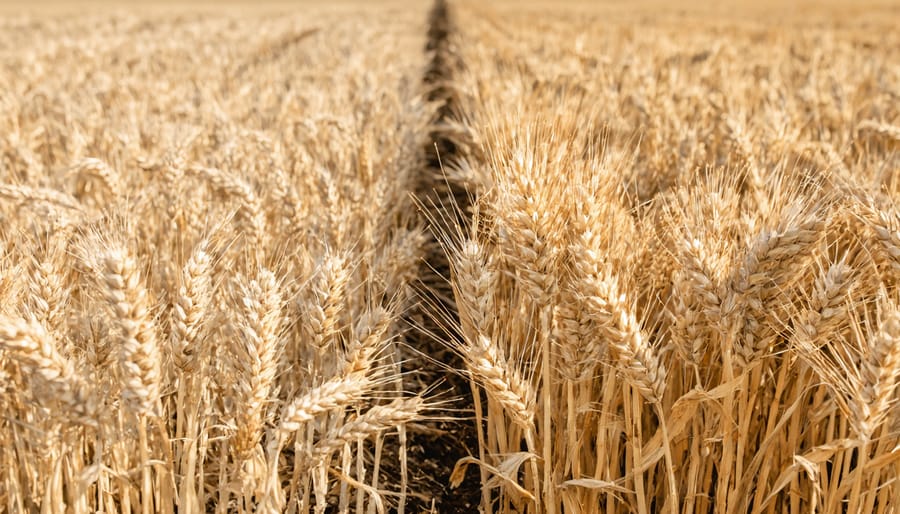
Central Alberta Market Garden Experience
In 2021, Sarah and James McKenzie transformed their 5-hectare market garden in Red Deer County into a showcase of effective water retention practices. By implementing a combination of organic matter enhancement and strategic mulching techniques, they achieved remarkable results in their first growing season.
“We started by adding locally sourced compost and aged manure to increase our soil’s organic matter content from 2% to 4.5%,” Sarah explains. “The difference was noticeable within months.” Their water consumption decreased by 35% compared to the previous year, while crop yields increased by 20%.
The McKenzies also introduced wood chip mulching around their high-value crops, maintaining a consistent 10-centimetre layer. This practice proved especially beneficial during Alberta’s characteristic dry spells, reducing irrigation frequency from three times to once per week.
Their success has inspired neighboring farms, leading to the formation of the Central Alberta Soil Health Network. The group now hosts monthly workshops where farmers share experiences and techniques for improving soil water retention.
“What worked best for us was starting small,” James notes. “We tested these methods on a quarter-hectare plot before scaling up. It made the learning curve manageable and helped us avoid costly mistakes.” Today, their market garden serves as a learning hub for local farmers, demonstrating how practical soil management can lead to significant water conservation in Alberta’s climate.
Environmental Impact and Sustainability
Reducing Water Usage
Improving soil water retention directly leads to significant water conservation benefits for your farm. Many Alberta farmers have reported reducing their irrigation needs by 20-30% after implementing effective soil management practices. For example, the Peterson Family Farm in Lethbridge cut their water usage by 25% in the first season after adding organic matter and implementing no-till practices.
When soil effectively retains moisture, you can extend the time between irrigation cycles, particularly during critical growing periods. This not only saves water but also reduces energy costs associated with pumping and distribution. Consider that every millimetre of water retained in your soil is one less millimetre you need to apply through irrigation.
The economic impact is substantial – farmers in Southern Alberta typically save between $15-25 per hectare in irrigation costs annually through improved soil water retention. Beyond the financial benefits, reduced water usage helps maintain groundwater levels and supports sustainable water management across our agricultural communities.
Remember that water conservation through better soil management isn’t just about environmental stewardship – it’s about building resilience into your farming operation and ensuring long-term sustainability for future generations.
Soil Health Benefits
When soil effectively retains water, it creates a thriving ecosystem that benefits the entire farm. Through sustainable soil practices, farmers across Alberta have reported significant improvements in soil structure and biological activity. Enhanced water retention leads to increased organic matter content, which acts as a natural sponge, creating a cycle of continuous improvement.
The presence of adequate moisture supports beneficial microorganisms and earthworms, which help break down organic matter and create stable soil aggregates. This improved soil structure allows for better root penetration and nutrient cycling, resulting in healthier crops and reduced fertilizer needs.
Many Alberta farmers have noticed that fields with good water retention show greater resilience during dry spells and recover more quickly after extreme weather events. The enhanced soil biodiversity also helps suppress plant diseases naturally, reducing the need for chemical interventions.
Long-term studies in the Prairie region demonstrate that properly managed soils with good water retention can increase organic matter content by 0.5% to 1% over five years, leading to more sustainable and productive farming systems.
As we’ve explored throughout this article, nanotechnology solutions for soil water retention offer tremendous potential for Canadian agriculture, particularly in regions like Alberta where water management is crucial. The benefits are clear: improved crop yields, reduced irrigation needs, and more resilient farming operations in the face of changing climate conditions.
By implementing these innovative solutions, farmers across Alberta have reported water savings of up to 30% while maintaining or improving their crop yields. These results demonstrate that the initial investment in nanotech materials can lead to significant long-term returns, both environmentally and economically.
The success stories we’ve shared from local farms show that these technologies are not just theoretical – they’re practical solutions that work in our unique Canadian growing conditions. From small-scale operations to large agricultural enterprises, the adaptability of nanotech solutions makes them accessible to farms of all sizes.
Looking ahead, the adoption of soil water retention technology represents a forward-thinking approach to sustainable agriculture. As members of Canada’s farming community, we have the opportunity to lead the way in implementing these innovative solutions. The support available through agricultural extension services and local farming cooperatives makes it easier than ever to get started.
Consider taking the first step by consulting with local agricultural experts or joining community discussions about water retention solutions. Together, we can build a more sustainable and productive future for Canadian agriculture.



